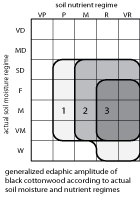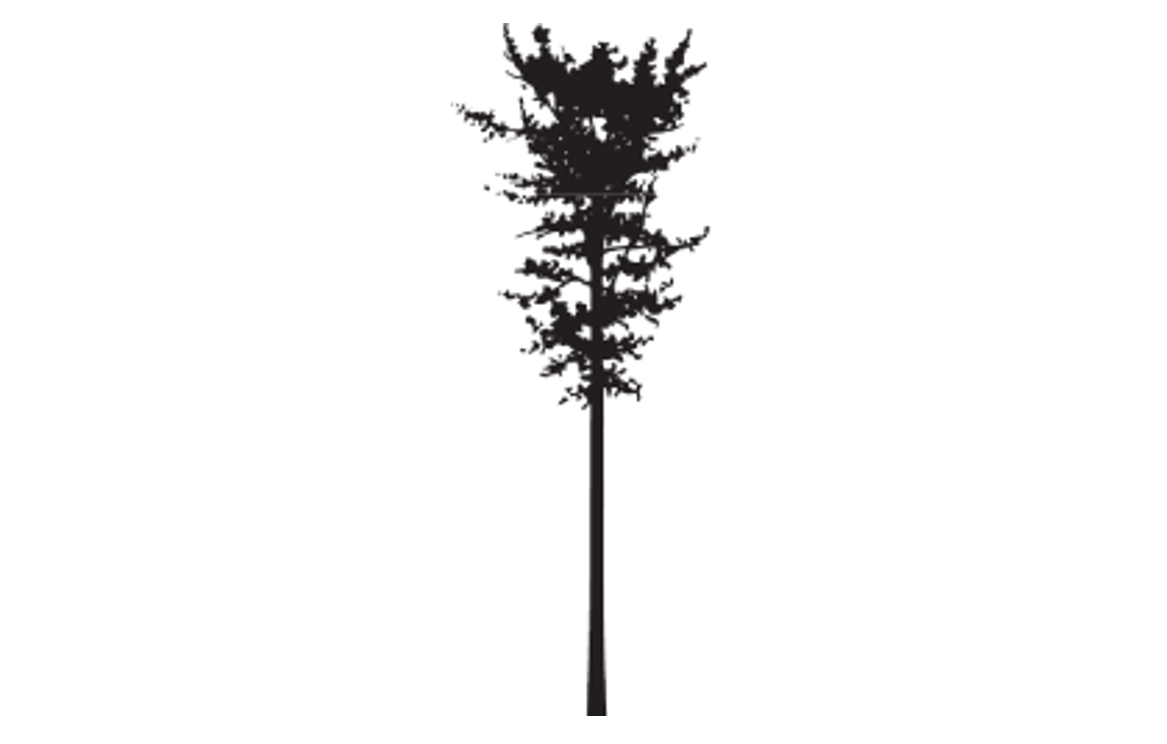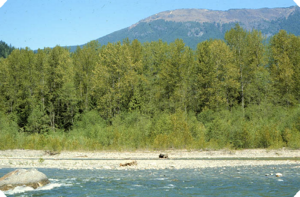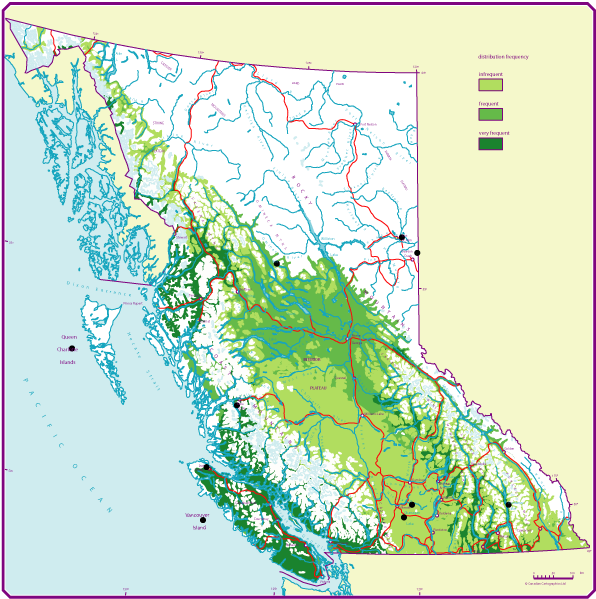Black cottonwood
On this page
- Geographic range and ecological amplitudes
- Tolerances and damaging agents
- Silvical characteristics
- Genetics and notes
Geographic range and ecological amplitudes
Description
Black cottonwood is a medium- to large-sized (exceptionally over 60m tall), deciduous broad-leaved tree, at maturity with a narrow, sometimes columnar crown, with a few thick ascending branches and dark gray, irregularly shaped furrows. Many kinds of wildlife use the foliage, twigs, and buds for food. The wood is light and soft and is used for lumber, veneer, and pulp.
Geographic range
Geographic element:
Western North American/Pacific and Cordilleran
Distribution in Western North America:
north, central, and south in the Pacific region; central and south in the Cordilleran region
Ecological amplitudes
Climatic amplitude:
(subalpine boreal) - montane boreal - cool temperate - cool mesothermal (absent or marginally in hypermaritime climates)
Orographic amplitude:
submontane - montane - (subalpine)
Occurrence in biogeoclimatic zones:
(lower MH), (lower ESSF), (MS), BWBS, SBS, (SBPS), (BG), (PP), IDF, ICH, CDF, CWH
Edaphic amplitude:

Range of soil moisture regimes:
slightly dry - fresh - moist - very moist - (wet)
Range of soil nutrient regimes:
(poor) - medium - rich - very rich
The edaphic amplitude of black cottonwood is very similar to that of balsam poplar. The major ecological difference between the two species is in their climatic requirements. While balsam poplar is mainly a subarctic or boreal tree, black cottonwood grows mainly in temperate and mesothermal climates, only marginally in subalpine boreal climates.
Tolerances and damaging agents
Root system characteristics
On floodplains, the root system of black cottonwood is multi-layered, owing to the deposition of new soil by periodic flooding. Although early root development is downward, subsequent growth progresses upward as root development occurs on the buried stem. Lateral root spread can be >15m. Roots are associated with ecto- and endo-mycorrhizae.
| Tolerance to | Tolerance class | Comments |
|---|---|---|
| low light | L | a very intolerant, exposure-requiring species |
| frost | M | lower in coastal populations |
| heat | M | absent on insolated sites |
| water deficit | L | absent on water-deficient sites |
| water surplus | H | tolerates flooding and strongly fluctuating water table well; intolerant of brackish water |
| nutrient (mainly N) deficiency | L | absent in acid, very poor soils |
| Damaging agent | Resistance class | Comments |
|---|---|---|
| snow | M | high snowfall will break branches rather than boles |
| wind | H | high winds will break the boles rather than uproot trees |
| Risk class | ||
|---|---|---|
| fire | L | fire risk in cottonwood stands is very low |
| insect | L | not a major concern |
| fungi | L | not a serious concern [heart rots (for example, brown stringy trunk rot of hardwoods)]; leaf rust (Melampsora spp.) |
| other agents | L | not a major concern; browsing by large ungulates; root browsing and girdling by voles and mice |
Associated tree species and successional role
In British Columbia, black cottonwood grows predominantly in even-aged, pure stands, and, in the later stages of primary succession on floodplains, with many shade-tolerant conifers. Black cottonwood is a pioneer species (primary succession) on floodplains, and is present in early seral and mid-seral stages of secondary succession on floodplains and upland sites.
| Associated tree species |
Occurance class | Major area of occurance |
|---|---|---|
| western redcedar | M | generally replacing black cottonwood in the final stage of primary succession in cool temperate and mesothermal climates |
| sitka spruce | M | only in maritime climates |
| red alder | M | floodplains in southern coastal B.C |
| white spruce (& hybrids) | M | mainly in boreal climates |
| trembling aspen | L | mainly in boreal and cool temperate climates |
| lodgepole pine | L | cool temperate and montane boreal climates |
| black spruce | L | BWBS |
| bigleaf maple | L | southern coastal B.C |
| grand fir | L | southern B.C |
| subalpine fir | L | mainly in ICH |
Genetics and notes
Genetics
Black cottonwood exhibits considerable variation throughout its range. Balsam poplar and black cottonwood hybridize and produce frequently mixed populations where both taxa are sympatric or even where they are separated by rather large distances. This hybridization may be considered intraspecific (see balsam poplar).
Notes
Bell, D.S. 1990. Populus trichocarpa. Pp. 570-582 in R.M. Burns and B.H. Honkala (technical coordinators) Silvics of North America, Vol. 2. Agri. Handbook 654, USDA For. Serv., Washington, D.C.
Black cottonwood produces in a short time (?30 years) high yields of wood suitable for mechanical pulping. Considering its productivity, vegetative reproduction, and low risk of being affected by damaging agents, it is a suitable species for intensive management on flooded sites. More detailed silvics information is given by:

This is the general shape and outline of the black cottonwood.

An immature stand of black cottonwood adjacent to the Chilliwack River. Black cottonwood and balsam are distinguished from other tree species by the highest rate of early growth.

